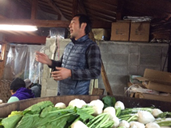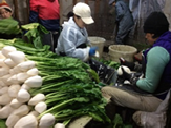Gravity(Attraction) of Kyoto 15 Pottery and Pickles Ⅱ Suguki, Kamo eggplant, and Miyako vegetables
Yoshie Doi
 |
 |
Suguki hut at Yasumi Farm
Every December, I visit the “Suguki hut” of Yasumi Farm, a Kyoto vegetable farm in Kamigamo, to buy Suguki pickles. The delicious aroma of Suguki pickles wafts from about 10 meters in front of the hut.
Once the pickling process is complete, the Suguki pickles are left in a room at around 40 ℃ for about a week to promote lactic acid fermentation. This is the smell and taste of winter in Kyoto. Because it undergoes lactic acid fermentation, it seems to regulate the stomach and intestines, and also helps those who suffer from constipation to have regular bowel movements. If you think this may be the case, please give it a try.
The history of Suguki dates back 400 years, when a priest of Kamigamo Shrine brought home a plant he found on the banks of the Kamo River. The Honcho Shoshokukagami, published around the time of the Genroku era in the Edo period, states that Suguki are called sour stems because they develop a sour taste over time. They have been sold in Kyoto since the end of the Meiji period, and in Osaka and Tokyo since the Taisho period. The practice of pickling Suguki using a balance (Tenbinzuke:using a balance) dates back to the early Showa period.
During the Edo period, Suguki was a special product of Kamigamo, and was treasured as a gift for the Imperial Palace, nobles, and upper classes in the Kyoto area, not from autumn to winter, but in early summer. Due to its characteristics, Suguki was also used as a pickle.
One theory is that Suguki began as a plant bestowed by the Imperial Palace, but it seems that it was first cultivated by the shrine priests of Kamigamo Shrine. Suguki, which was originally cultivated within the shrine priests’ estates, began to be grown by ordinary farmers at the end of the Edo period. As the cultivation area was limited to a small area of Kamigamo, west of Matsugazaki and north of Kitayama Street, it was cultivated as a closely guarded secret. It began to become popular among the general public after the Meiji Restoration, towards the end of the Meiji period. Suguki then became established as a luxury gift item.
In 1804, the Shoshidai issued a letter of instruction entitled “Okakituke-koujokaki” (Courtesy of the Governor) prohibiting the export of Suguki to other villages, stating in red ink that “it is forbidden to export even a single Suguki tree to another village,” and neither the cultivation techniques nor even a single seed were allowed to be taken out. Due to the climate and natural features of the area, the precious fermentation techniques for Suguki have been passed down to the present day only in Kamigamo.
Among the lactic acid bacteria contained in Suguki pickles, Lactobacillus casei was discovered in Suguki pickles by Dr. Kishida Tunataro of the Kyoto Pasteur Institute. Research has revealed that it increases the body’s ability to produce interferon (a factor that protects the body from cancer and viruses), and has the potential to be a safe, side-effect-free immune booster, and some pickle shops now use Lactobacillus casei.
I was previously asking a Kyoto vegetable farmer in Fushimi about Suguki, and he told me to ask a Suguki farmer in Kamigamo about Suguki. He said that even though they are both Kyoto vegetable farmers, only Kamigamo farmers would know the details about Suguki.
Kyoto vegetables are classified into “Kyoto traditional vegetables” and “Kyoto brand products.” “Kyoto traditional vegetables” are 23 designated varieties that are native varieties grown in the climate of Kyoto. “Kyoto brand products” are agricultural products that meet the standards independently established by Kyoto Prefecture, and include not only vegetables but also fruits, rice, and processed products.
While many Kyoto vegetables from other prefectures are sold, President Daiki Higashimoto of Miyako Yasai Kamo had doubts about this and named vegetables grown in Kyoto “Miyako Yasai.” Miyako Yasai, picked that morning, are served in the store as a farm bar buffet. It has now become an all-you-can-eat vegetable restaurant with long lines. The Osaka Station store implements a No-Foodloss Time from 9pm depending on the situation, and provides excellent customer service. This new challenge with Kyoto vegetables is helping to spread the appeal of Kyoto and Miyako vegetables.
The reason why it has the word “Kyo” in its name is a bit tricky. About 10 years ago, when I went to Paris and paid courtesy visits to several government agencies, I heard an interesting story. Apparently, when they grew Kyoto vegetables in the fields of the Palace of Versailles and held a dinner party, the Kamo eggplants did not grow large and did not develop their dark blue color.
This is more like a Versailles vegetable than a Kyoto vegetable. Kamo eggplants are a delicate variety, and traditional cultivation techniques, planting times, and fruiting timing are difficult. They often fail unless grown in Kyoto’s climate, soil, and using traditional cultivation techniques. Even with three times the water and three times the fertilizer of a regular eggplant, it’s a time-consuming variety that only produces one-third of the harvest.
The deliciousness of Kyoto vegetables is surely the result of the farmers’ love and painstaking work, as well as the climate, soil microorganisms and ingredients. I am once again impressed by the wonder and deliciousness of Kyoto vegetables.
(Continued in the next issue)
The end of document
Translated by Masami Otani
